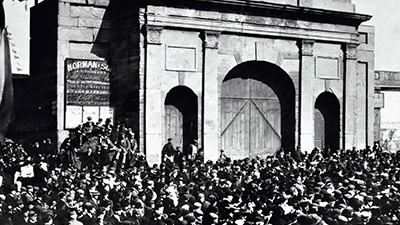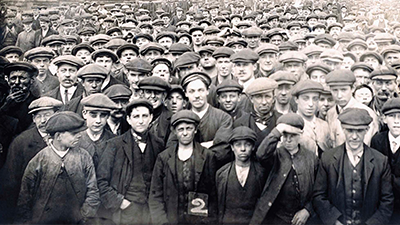Reactions to the Industrial Economy from 1750 to 1900 CE
Teacher Resources
Driving Question: What caused demands for change in industrial societies from 1750 to 1900 CE, and how did these demands shape society?
As industrialization spread, it transformed societies. Industrial capitalism enriched some, but many others struggled in the face of industrial changes. A new urban working class emerged, paid an hourly wage in exchange for their labor. Living and working conditions were often miserable. As a result, new economic ideologies, like socialism, emerged to challenge capitalism. In many places, the working class united to demand better pay and working conditions.
Learning Objectives
- Compare and contrast the economic systems of capitalism and socialism.
- Evaluate how different groups responded to increasing industrialization from c. 1750 to 1900 CE.
- Explain the causes and effects of calls for changes in industrial societies from 1750 to 1900.
Vocab Terms:
- bourgeoisie
- capitalism
- industrial capitalist
- proletariat
- reform
- social class
- union
Opener: Reactions to the Industrial Economy
To teach this lesson step, refer to page 3 of the Lesson 5.8 Teaching Guide.
There are a variety of ways to approach SAQs. Learn more in the Community thread How to SAQ with Jessica Lindenmeier.
By now, you’ve probably gotten pretty good at using evidence from an image to support your claims. So this time, we’re going to send you to find the images that support your claims.
Responses to Industrialization
To teach this lesson step, refer to page 5 of the Lesson 5.8 Teaching Guide.
Every revolution causes some sort of response. Industrialization did—in fact, it shook up ideas about who gets what, where, when, and how!
-
Guiding Questions
-
Before you read
Preview the questions below, and then skim the article. Be sure to look at the section headings and any images.
While you read
Look for answers to these questions:
- How did Evangelical Christianity inspire some reformers?
- What was the connection between the anti-slavery movement and the women’s rights movement?
- What were some effects of industrialization which Upton Sinclair highlighted in his book?
- What was life like in the tenements?
- What were some of the successes of the reform movement?
After you read
Respond to the following questions:
- Prepare an argument that explains how industrialization caused change in existing hierarchies and standards of living. Use evidence from the article to support your answer.
- You have learned about changes in people’s lives due to the Industrial Revolution from several articles and videos in this unit. Now we want to ask you who determined what changes happened and how. Were the wealthy and powerful the only people who could make change? How much change could individuals or groups of everyday people make happen?
Would You Rather?
Unlike those who lived through the Industrial Revolution, you do get to choose. In this activity, explore different options to get a feel for what life was really like back then.
Rise of the Proletariat
To teach this lesson step, refer to page 6 of the Lesson 5.8 Teaching Guide.
Workers during the Industrial Revolution had only their labor to give—but they wanted a better wage for that labor.
-
Guiding Questions
-
Before you read
Preview the questions below, and then skim the article. Be sure to look at the section headings and any images.
While you read
Look for answers to these questions:
- Industrialists owned the means of production under industrial capitalism. What are the means of production, and how did controlling them make industrialists powerful?
- Why did industrialists begin to hire women, and what were their experiences?
- What were conditions like for workers overall?
- What is the proletariat?
- How did workers begin to organize into alliances like unions, and what were their principal tactics?
- Why was there less union organizing in the colonies?
After you read
Respond to the following questions:
- Describe the extent to which this article explains the causes and effects of calls for change in industrial societies from 1750 to 1900.
- Does the author of this article seem more sympathetic towards workers or towards industrialists? Do you think their sympathies change how you understand this article?
- This article defines and describes the proletariat class. Looking around your world today, do you think there is still a proletariat? If so, has it changed at all since the long nineteenth century? How?
Sourcing: Reactions to Industrialization
To teach this lesson step, refer to page 8 of the Lesson 5.8 Teaching Guide.
Need a way to give students feedback on their sourcing skills? Check out this Sourcing Feedback Form.
Industrialization and imperialism provoked many different responses. In this exercise, you will examine primary sources to examine two distinct opinions regarding the social and economic conditions of the time. We recommend you use the Quick-Sourcing Tool to complete this exercise.
Closer: Reactions to the Industrial Economy
To teach this lesson step, refer to page 14 of the Lesson 5.8 Teaching Guide.
Wanting to include more women in history class? This blog post is full of ideas!
Who better to learn the perspective of an industrial-era worker from than from an industrial-era worker? You will read the story of Ottilie Baader, who started as a worker and became a labor organizer.
-
Guiding Questions
-
Before you read
Skim the full comic, paying attention to things like prominent colors, shapes, and types of text and fonts. How do you know where to start and which direction to read? What’s in the gutters (the space between panels)? Who is the focus of the comic? What big questions do you have?
While you read
Look for answers to these questions:
- When was Ottilie Baader born, and how old was she when she began school? What did she learn there?
- When did Ottilie begin working, and why? What were her days like at that age?
- What was Ottilie’s job in the wool factory like?
- Why did Ottilie become a labor organizer around 1871?
- How does the artist use design not only to depict Baader’s life as a factory worker, but also her attempts to change her conditions?
After you read
Respond to the following questions:
- What evidence does Ottilie Baader’s story provide about industrialization as an engine of change in people’s lives?
- How does it support, extend, or challenge what you have already learned about the impact of the Industrial Revolution?





